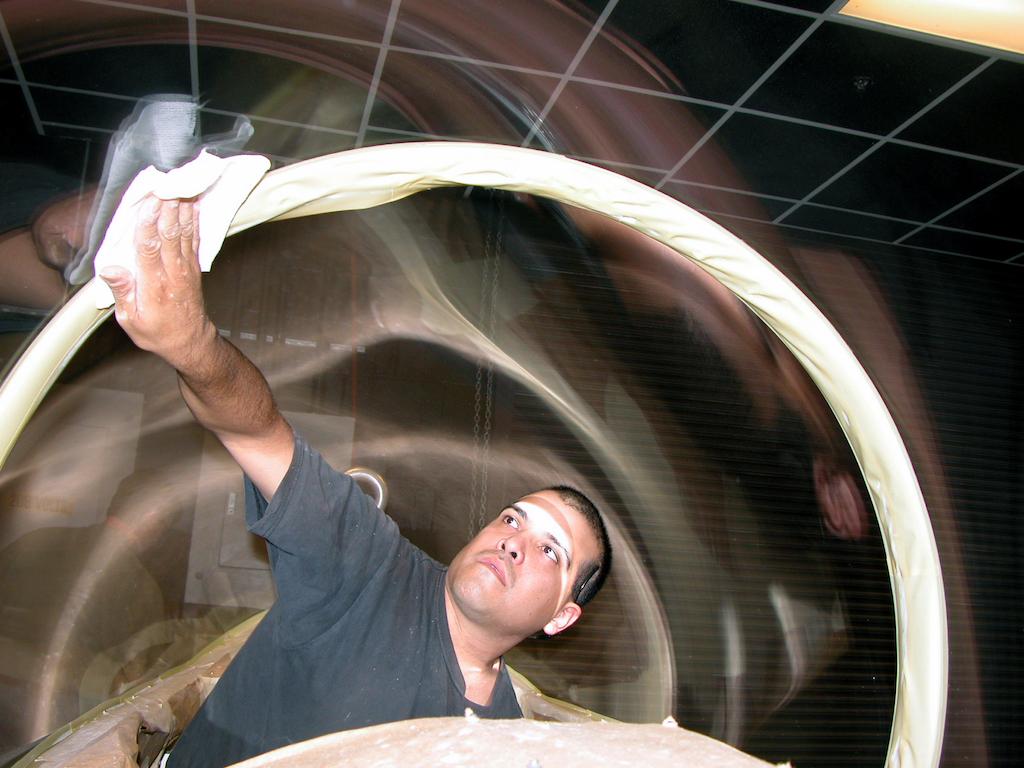Windscreen Distortions Can Affect Pilots’ Perception, Part 2

The polishing and buffing process on this F-15 refurbished canopy uses specially textured papers that become finer at each level, removing nicks and scratches from the acrylic.
There are many causes of windscreen crazing, or fine cracking, some due to manufacturing stresses that pilots and mechanics cannot control. The common cause of crazing that pilots and mechanics can prevent is exposure to organic fluids and vapors. Although acrylics can withstand some amount of exposure to inorganic and organic materials, the aviation industry uses some compounds that severely degrade acrylics.
Challenger Service and Repair Manual 56-15-01 (Page 3) advises owners: “Do not use chlorinated hydrocarbon cleaners such as Trichloroethane on or near windshield/window panels. These cleaners and their vapors can cause crazing damage on acrylic panel surfaces.”
Do not use gasoline, alcohol, benzene, acetone, carbon tetrachloride, fire extinguisher or deicing fluids, lacquer thinners, or window cleaning sprays because they will soften the plastic and cause crazing.
Polycarbonates and ‘Rainbowing’
Polycarbonate windscreens are used on a wide range of helicopters and light aircraft, especially those with complex curved shapes. The benefits of polycarbonate are their impact strength characteristics throughout an aircraft’s normal temperature range, which are much higher than for acrylics.
Conversely, polycarbonates are susceptible to degradation from the environment. This is mostly from moisture absorption, solvent stress cracking, and UV exposure. It is possible to reduce the degradation through good design and production practices and incorporating coatings. Polycarbonates also suffer from physical aging, which results in the change from ductile to brittle properties.
The earlier mentioned study of the optical characteristics of aircraft windshields by the Armstrong Aerospace Medical Research Laboratory found that polycarbonate windscreens under stress develop two indices of refraction (the “index of refraction” is a measure of how much the path of light is bent when entering a material), causing polarized light to travel at different velocities through the material. When light exits the windscreen, the angle of exit results in some wavelengths being distorted more than others. Thus, the exiting light exhibits a color “rainbow” effect.
This pattern can be relatively strong on clear blue days. The colors will vary depending on the orientation of the windscreen with respect to the incoming light. By the way, donning a pair of polarized sunglasses replicates this effect. The distortion will detract from a pilot’s ability to accurately view the outside world.
Distortions From Rain
A rain-covered windscreen distorts light waves as they pass through the windscreen. Water depth depends on an aircraft’s speed, pitch, and the use of rain removal equipment such as wipers, which can further degrade a pilot’s ability to see in front of the aircraft. A rain-covered windshield can distort the image of the runway, enough to make it difficult to accurately perceive the runway’s position and the aircraft’s aim point.
In daylight conditions, water on the windscreen tends to make objects appear farther away than they actually are. The pilot would believe that he or she is higher and further away from his planned touchdown point than in actuality. This results in the flight crew tending to fly a shallow flight path.
In night lighting conditions, rain increases the apparent brilliance of the approach light system, which tricks the pilot’s eye into thinking the runway is closer than it really is. This tends to induce a pitch-down input and risks landing short of the runway threshold.
Common methods to remove rain utilize one or a combination of windshield wipers, chemical rain repellent, pneumatic rain removal (bleed air), windscreens treated with a hydrophobic surface seal coating or through aerodynamic shaping.
Movement of the windshield wipers can produce an undesirable effect similar to flicker vertigo. Some pilots are more susceptible to this effect. In Human Factors in Flight, former KLM captain Frank Hawkins notes, “the wipers should not be operated faster than necessary, and the pilot should not look continuously through them longer than is required.”
Chemical repellent is a little bit more complicated, as the point of the chemical on the windscreen is to draw water into beads. However, this will only cover a portion of the windscreen. This can cause a distorted image between the portion covered by the chemical repellant versus the rest of the surface. Another drawback of this system is that the weather conditions need to be very wet as undiluted repellant can restrict the visibility of the windscreen.
Another method to reduce the effect of rain on an aircraft’s windscreen is an external hydrophobic coating. The coating causes the rain to bead up, with the beads then blown off, reducing the need for windshield wipers. Eventually the coating will fade, and less permanent coatings will need to be applied periodically to the windshield.
Pneumatic rain removal is heated bleed air that is blown across the windscreen. When the bleed air is blown across the windscreen, it breaks apart the water into smaller drops that are then blown off the surface. Since the index of refraction (think distortion) varies with the temperature, a large temperature gradient between the heated and unheated portions of the windscreen may cause localized distortions.
Thermostats are designed within the windscreen heat system to keep the window from overheating, but like any element, these too can fail. If the heating is inadvertently left on during ground operations with no cooling air flow over the windscreen and if the windscreen heat system has malfunctioned, the windscreen can suffer from overheating. This will cause a peculiar wavy distortion looking through the windscreen.
Any amount of yawing or crabbing on the approach will further distort the runway’s image. Pilots must observe the limitations of their windscreen heating system to prevent windscreen damage.
In Part 3 of this article, we discuss halation and other windscreen distortions that can affect pilots’ perception.
Windscreen Distortions Can Affect Pilots’ Perception, Part 1: https://aviationweek.com/business-aviation/aircraft-propulsion/windscre…
